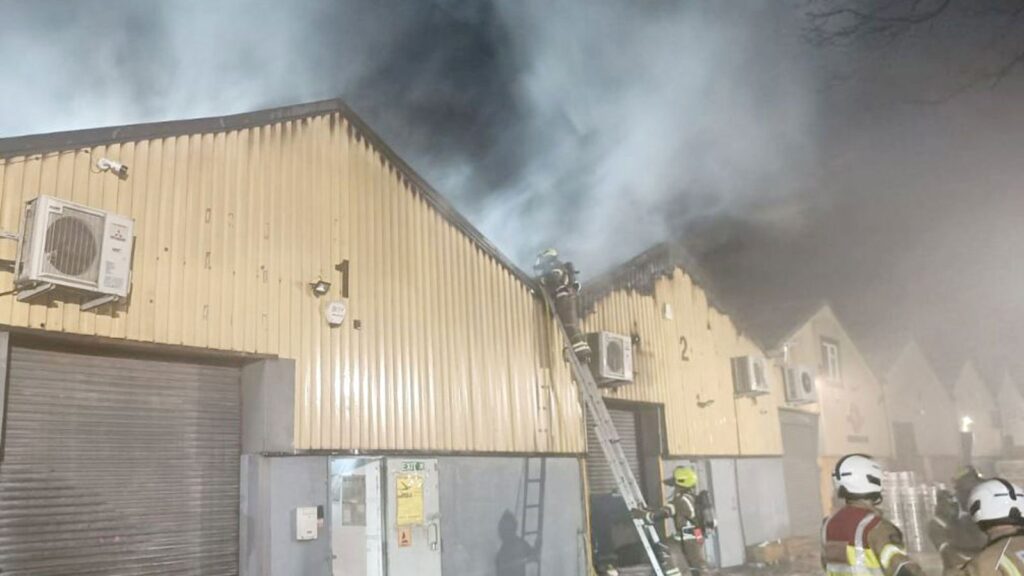What started out as a few sketchy messages on Telegram eventually exposed a deeply disturbing plot that brought chaos, fire, and international espionage to the heart of the UK.
Behind it all was a group of young British men, drawn into a dangerous game orchestrated by Russia’s Wagner Group—a group known for its brutal tactics and links to the Kremlin.
This wasn’t just a random act of arson.
It was part of a sabotage campaign aimed at disrupting aid to Ukraine and targeting high-profile Russian dissidents living in London.
From Telegram Chat to Terrorist Plot
The plot was spearheaded by Dylan Earl, a 21-year-old builder living with his parents in Leicestershire.
He wasn’t just another young man wasting time online—Earl was deep into the world of conspiracy and conflict.
He followed a pro-Wagner Telegram channel called Grey Zone, which acted as a recruitment hub for sympathizers across Europe.
Earl reached out to a contact named “Minsk KGB,” stating he wanted a fresh start in Russia, though he barely spoke the language.
Through a mix of broken Russian and Google Translate, he communicated with a chatbot named “Privet Bot” that assigned him tasks—starting with arson.
Warehouse Inferno: The First Mission
On March 20, 2023, Earl mobilized a small group to attack a warehouse in Leyton, East London.
The warehouse stored crucial Starlink satellite equipment destined for Ukraine—equipment that helps keep Ukrainian communications alive during war.
Jake Reeves, 23, who worked as an aircraft cleaner and was obsessed with violent video games, subcontracted the job to his former college mates: Nii Kojo Mensah and Jakeem Rose.
They were joined by Ugnius Asmena, who recruited a 61-year-old neighbor, Paul English, as a getaway driver using a barely-functioning red Kia Picanto.
The crew poured petrol around the warehouse and set it ablaze.
The fire destroyed over £100,000 worth of equipment and severely damaged the building.
Unfortunately for the gang, they forgot to record proof of the attack for their Russian contacts—and that mistake cost them their promised payment.
Russian Frustration and an Aborted Kidnapping
The Russians weren’t happy. Earl was scolded for failing to notify them before the attack and for not providing footage.
Still desperate to impress, he begged for a second chance—offering to carry out more missions and even build partisan cells in Europe.
Plans were then hatched to torch an upscale Mayfair restaurant and kidnap its Russian dissident owner, Evgeny Chichvarkin, a vocal critic of Putin who had helped send humanitarian aid to Ukraine.
The mission never got Russian approval, and no payment came through.
Digital Bread Crumbs and Police Surveillance
Despite the group’s attempt at secrecy, they left behind a trail of digital evidence and CCTV footage.
Rose even left a knife with his DNA at the crime scene.
Messages showed the group joking about the attack, desperate for payment, and planning future operations including bombings and abductions.
Police managed to identify the team through vehicle registrations and phone records.
Earl was eventually arrested in a B&Q car park in Leicestershire.
When officers raided his home, they discovered cash, cryptocurrency worth nearly £60,000, and nearly a kilo of cocaine.
The Courtroom Fallout
After a detailed investigation, several of the group members were brought to trial.
Dylan Earl and Jake Reeves both pleaded guilty to serious national security offenses and aggravated arson.
Three others—Mensah, Rose, and Asmena—were convicted after a jury deliberated for nearly 22 hours.
Paul English, the getaway driver, was found not guilty after convincing the jury he thought they were just picking up a vehicle.
Another man, Ashton Evans, a 20-year-old IT student from Wales, was convicted for failing to report a terrorist plot. He too had been approached by Earl.
The Human and Financial Cost
The warehouse fire didn’t just destroy goods—it endangered lives.
A lorry driver sleeping nearby had to leap into action to prevent the fire from spreading.
Eight fire engines and 60 firefighters battled the blaze.
In the end, goods worth over £100,000 were lost, and the building suffered more than £1 million in damage.
The building had housed goods like Starlink devices and generators intended for Ukraine, highlighting the political and humanitarian cost of the sabotage.
A Bigger Picture: Ideology, Greed, or Both?
Prosecutors noted that while some of the defendants may have acted out of greed, others clearly held ideological motivations, aligning themselves with Russia’s war aims.
Earl, especially, fantasized about becoming a top-tier spy and building alliances between the Wagner Group and criminal organizations like the IRA.
In messages to contacts, he expressed admiration for Russia’s efforts and resentment toward the West, revealing a chilling mix of naivety and radicalization.
The Targets That Never Were
The Mayfair targets—Hide restaurant and Hedonism Wines—employ hundreds and are worth over £30 million.
Residential spaces above these buildings meant that another fire could have had deadly consequences.
Luckily, this part of the plan never reached execution.
One surveillance operative, Kaiyan Oliveira (aka NazioMusic), was even caught on CCTV scouting the area.
Messages between gang members revealed how close they came to making the second attack a reality.
What Happens Next?
With the trial now concluded, and multiple convictions secured under the new National Security Act 2023, the case sends a strong message: the UK is taking threats from hostile foreign actors seriously.
David Cawthorne from the Crown Prosecution Service emphasized that these kinds of state-backed operations will be met with full force under the law.
The plot exposed not just a gang of misguided criminals, but a web of ideological recruitment, international manipulation, and digital warfare—all taking place from smartphones in quiet British neighborhoods.

